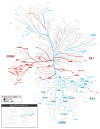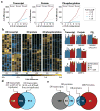Proteomic and phosphoproteomic comparison of human ES and iPS cells
- PMID: 21983960
- PMCID: PMC3432645
- DOI: 10.1038/nmeth.1699
Proteomic and phosphoproteomic comparison of human ES and iPS cells
Abstract
Combining high-mass-accuracy mass spectrometry, isobaric tagging and software for multiplexed, large-scale protein quantification, we report deep proteomic coverage of four human embryonic stem cell and four induced pluripotent stem cell lines in biological triplicate. This 24-sample comparison resulted in a very large set of identified proteins and phosphorylation sites in pluripotent cells. The statistical analysis afforded by our approach revealed subtle but reproducible differences in protein expression and protein phosphorylation between embryonic stem cells and induced pluripotent cells. Merging these results with RNA-seq analysis data, we found functionally related differences across each tier of regulation. We also introduce the Stem Cell-Omics Repository (SCOR), a resource to collate and display quantitative information across multiple planes of measurement, including mRNA, protein and post-translational modifications.
Conflict of interest statement
J.A.T. is a founder, stockowner, consultant and board member of Cellular Dynamics International (CDI), and serves as scientific advisor to and has financial interests in Tactics II Stem Cell Ventures.
Figures




Comment in
-
The proteomes of native and induced pluripotent stem cells.Nat Methods. 2011 Sep 29;8(10):807-8. doi: 10.1038/nmeth.1707. Nat Methods. 2011. PMID: 21959134 No abstract available.
References
Publication types
MeSH terms
Substances
Grants and funding
LinkOut - more resources
Full Text Sources
Other Literature Sources
Molecular Biology Databases
Research Materials

